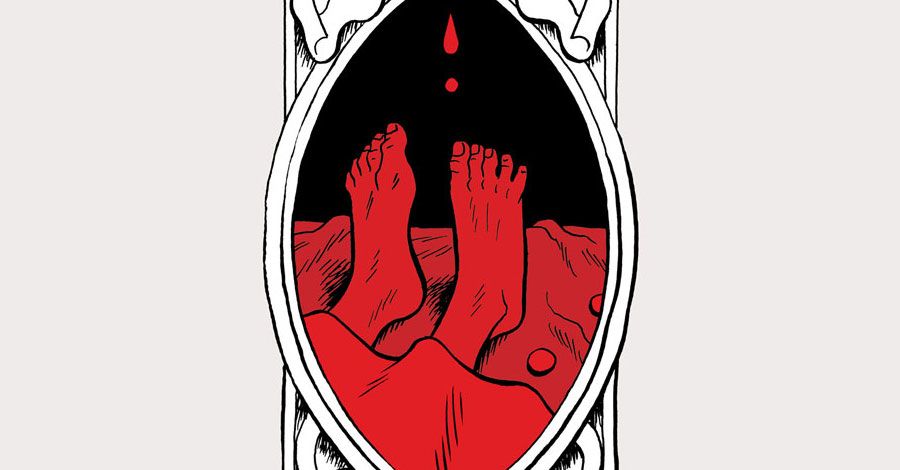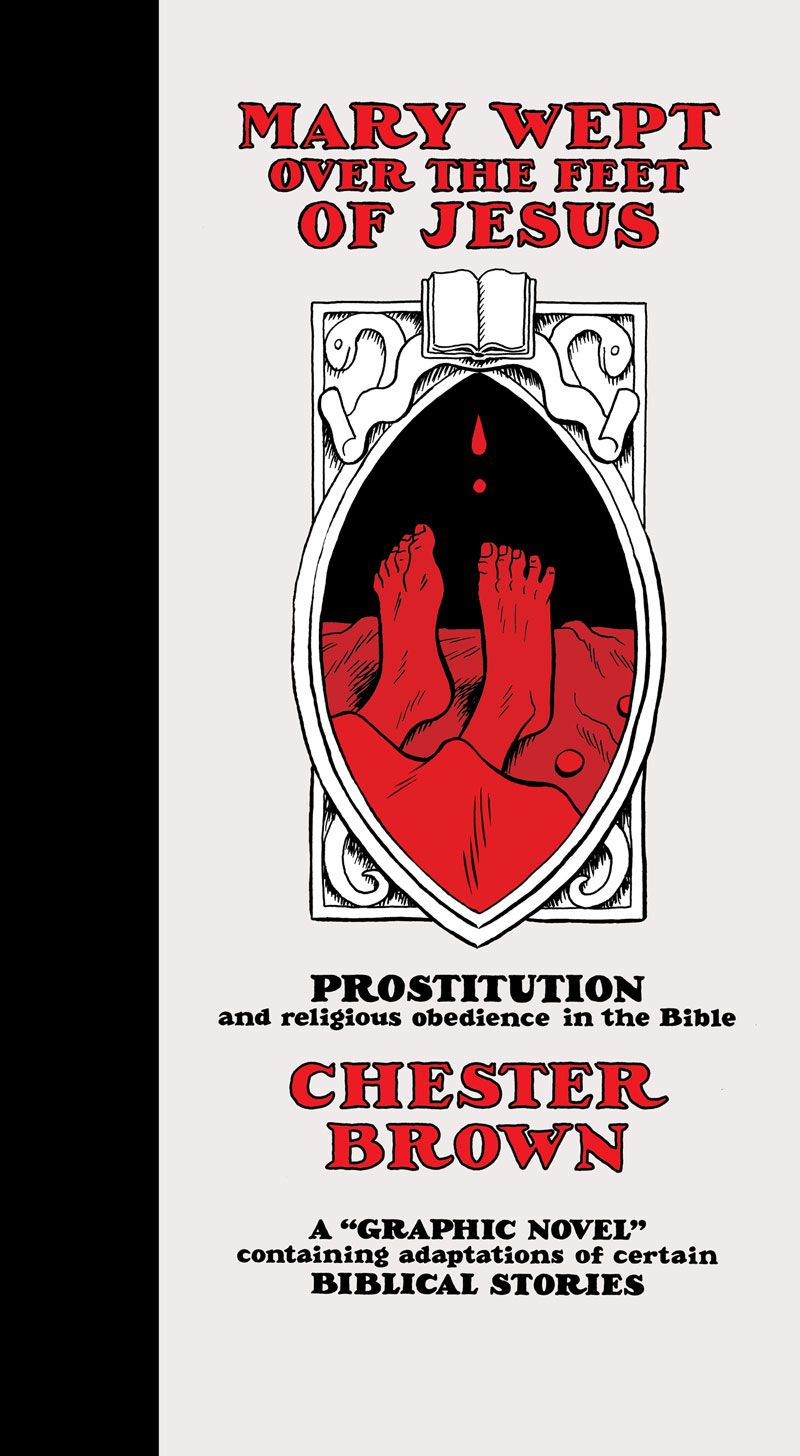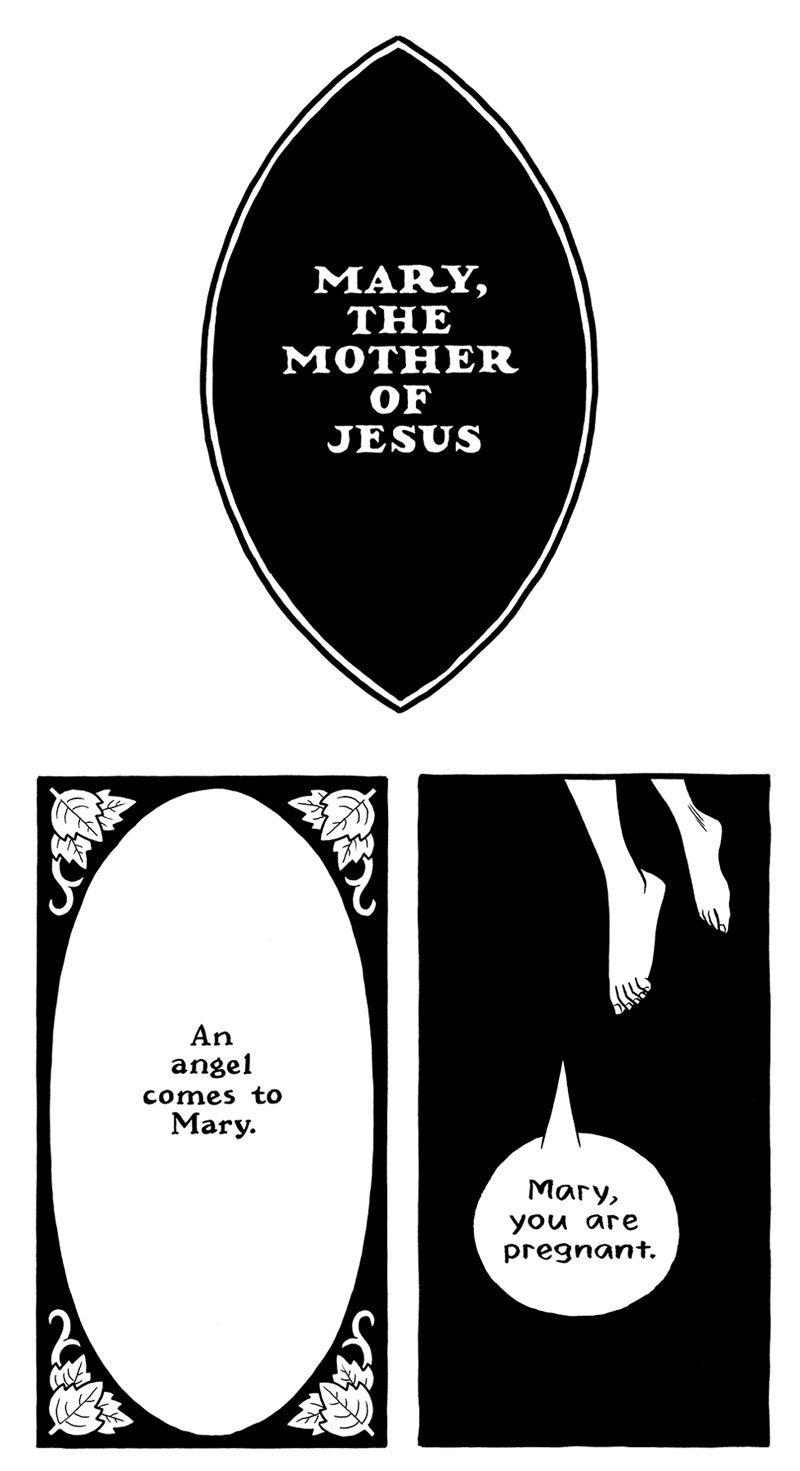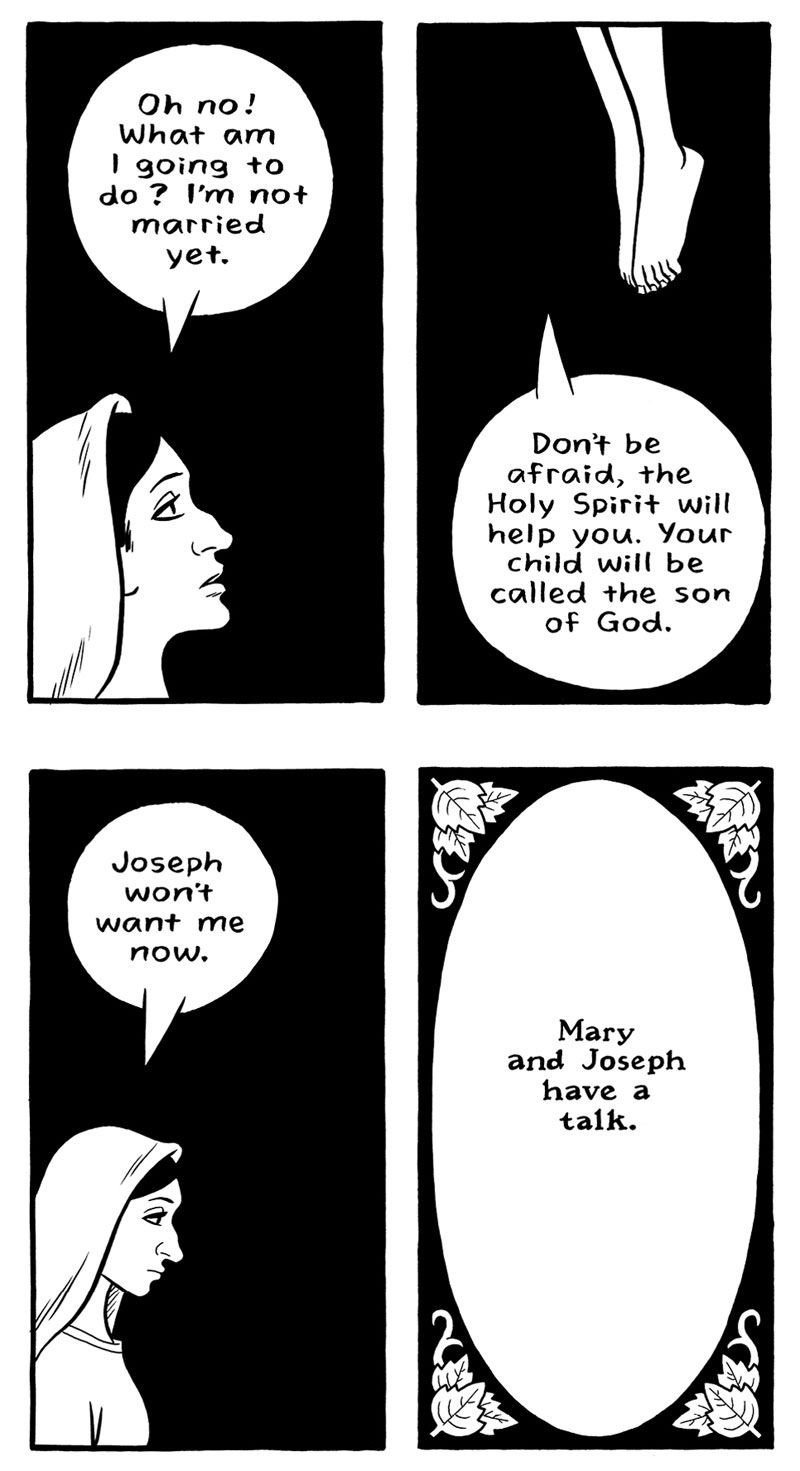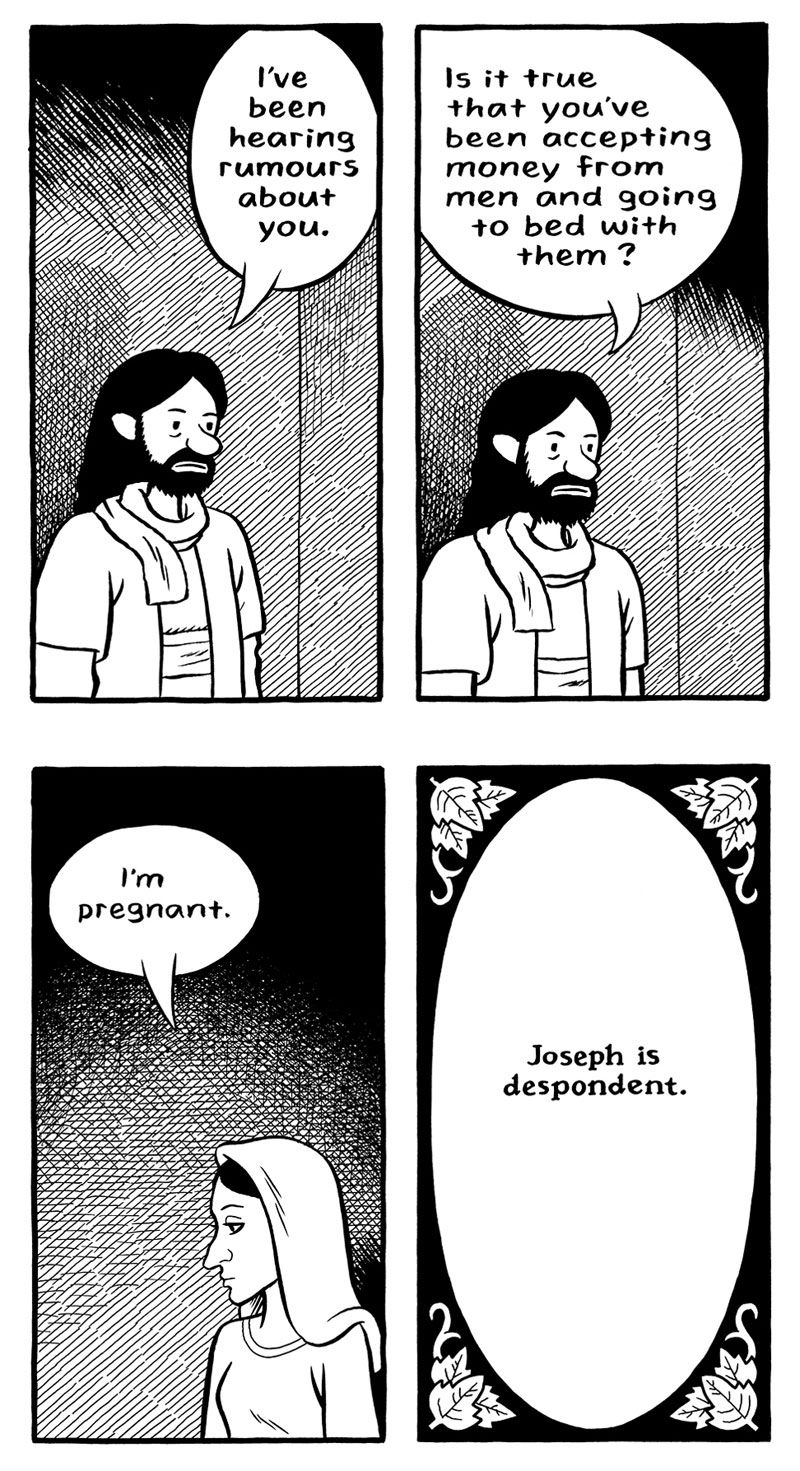Chester Brown redefined the comic book biography with "Louis Riel." He chronicled his own life as a john in "Paying For It." Now, the master cartoonist digs into the Bible to explore what Jesus himself thought of sex work.
In "Mary Wept Over the Feet of Jesus," Brown illustrates Bible stories involving the genealogy of Mary, mother of Jesus. Detailed research into the roots and earliest known translations of the stories fuels Brown's unique reading of these tales -- that Jesus Christ accepted prostitution as a legitimate profession. Copious appendices offer readers detailed insight into his logic, as well as the ancient textual roots of each creative choice.
CBR News spoke with Brown about how his latest project fits in with his own Christian beliefs, and the research involved in reinterpreting the Biblical stories presented in "Mary Wept."
CBR News: Chester, I think a lot of people will hear about this book and assume, "total blasphemy!" So let's start with a couple bona fides -- do you consider yourself a Christian?
Chester Brown: I'm definitely religious -- I believe there's a God of some sort. If I was forced to use one word to categorize myself religiously, I'd say I'm a Christian. I was raised as a Christian, and it's still the belief tradition that I'm closest to, but since I don't think Jesus was divine, there are probably Christians who wouldn't accept me as a fellow Christian.
Were you knowledgeable about the Bible prior to starting this project?
I read a book called "The Gospel Records" by William Scott back in 1983, when I was probably 22, or maybe 23. It was published in 1947, and even then it would have been an obscure book by an unknown biblical scholar, but it was my first encounter with serious biblical analysis, and I was fascinated. I immediately began searching for similar books and reading the Bible. I already had a pretty good grounding in the subject because my mother regularly read Bible stories to me and my brother when we were children. Anyway, that fascination with the Good Book has stayed with me since 1983, and I've continued to read about it.
Your notes on this book are incredible, and nearly as long as the comics themselves. For readers who've not had the chance to see it yet, how did the idea of retelling all the accounts of prostitution or sex work in the Bible evolve for you?
First, I should make it clear that I'm not retelling all of the stories about prostitution in the Bible -- just the ones that relate to a few points I'm trying to make.
Back in the late-'80s, I read a book called "The Illegitimacy of Jesus" by the biblical scholar Jane Schaberg. In it, she noted how odd it is that Jesus's genealogy in The Gospel Of Matthew features five women. Ancient genealogies rarely included women. All five women either had been or were rumored to have been involved in some sort of sexual impropriety. Why does Matthew emphasize sexual impropriety in his genealogy? Why, for example, does Matthew name the prostitute Rahab as an ancestor of Jesus? And why does Matthew not mention Naamah, a woman who was not associated with any sort of questionable sexual activity and who was the mother of Reheboam? (Reheboam is listed in the genealogy, so Naamah was an ancestor of Jesus in the same way that Rahab was.) In other words, why are the "bad" women (or the women who were rumored to have been "bad") listed, but not the "good" women? Why are women like Rahab in the genealogy, but not women like Naamah? Schaberg gave an explanation, which I ultimately found unsatisfactory. I came up with a different theory.
Then, in early 2014, I was reading a book by another biblical scholar: "The Power of Parable," by John Dominic Crossan. He mentioned the existence of an ancient, alternate version of Jesus's Parable Of The Talents. I'd never heard of this alternate version -- it's not in the Bible. It seemed to me that this version of The Talents confirmed what I'd been thinking about the genealogy in Matthew.
Within a few days of reading that passage in Crossan's book, I started writing the script for "Mary Wept Over The Feet Of Jesus."
Even at a cursory reading of these stories, it's most interesting that none of the women who engage in what many today might call immoral sexual conduct suffer any terrible fates. That seems to support your reading, doesn't it?
Not necessarily. For instance, David's transgression with Bathsheba results in what is essentially a murder. And the adultery and murder in that story lead to a larger tragedy that I didn't draw.
In "Mary Wept," I'm saying that I think Jesus approved of prostitution, not that the men who wrote the Bible did. While those men usually disapproved of women engaging in non-marital sex, they weren't writing simple morality stories, so there are instances where individual "sinners" seem to escape negative repercussions. One shouldn't mistake that for approval of "sin."
We should note that, based on your research, you have your own theories about certain Biblical characters and tales. However, all the theories presented here are not solely yours. What were the major sources that led to your interpretations?
I've already mentioned the two significant scholars who inspired the book, Jane Schaberg (who died back in 2012) and John Dominic Crossan. I don't know how much of "Mary Wept" they'd agree with -- perhaps none of it.
Writers Cynthia Bourgeault, Jim Marion and Paul Smith gave me framework for understanding Jesus from a different perspective, which made it possible for me to imagine that he might have approved of prostitution (although none of them say that). Of those three, Bourgeault was the most important for me since I encountered her book, "The Wisdom Jesus," first.
Also very important for me in clarifying spiritual and religious matters were the books of Byron Katie, particularly "Loving What Is" and "A Thousand Names For Joy." Everyone should read those two books -- Katie is the wisest person on the planet.
Do any of the stories of these women resonate with you more than the others?
Stories of love affect most of us, and that's just as true for me, despite the popular misconception that I'm anti-love. So the tale of Ruth's love for her mother-in-law, Naomi, is the one that resonates with me most powerfully.
The two tales that you reinterpret the most -- The Talents and The Prodigal Son -- don't really have paying for sex in their most popular tellings, though you've made paying for sex central in your re-telling. You discuss the reasons in your supplemental materials, but can you give us a quick overview about those stories? I think it gives some insight into how much thought and research you've put into this.
A small correction: the biblical version of The Prodigal Son does make it clear that the son spends his money on prostitutes.
I can give a quick overview, but I hope you'll excuse me for not attempting to demonstrate my research while doing so. The Parable Of The Talents is about a slave owner giving money to three of his slaves, and how that slave owner reacts to what the slaves do with the money. In the biblical version, there's no mention of prostitution. But, as I mentioned above, there is a variant of the story that seems to pre-date the biblical one. In that version, one of the slaves spends the money on prostitutes. What happens next in the story is up for debate, due to some less-than-clear language in the ancient source. To understand the parable, I compare it to The Parable Of The Prodigal Son, which I see as a related story. In the latter, a father, who symbolizes God, gives money to his son, who spends the money on prostitutes. The son is then embraced by the father. Symbolically, the whoremonger is embraced by God.
You've dived into the many translations and variations from the earliest written versions of these tales. Given how many translations these texts have received, and how many iterations of oral telling prior to ever being written down, can you ever feel certain about any interpretation of the Bible?
There are parts of the Bible that are clear and unambiguous, but there's a lot that's open to interpretation. Certainly, Jesus is a mysterious figure, and establishing exactly what he was trying to convey is difficult. People who take him seriously have a tendency to project their beliefs onto him, and it's possible that that's exactly what I'm doing in this book. Readers will have to evaluate for themselves whether or not my interpretations are correct.
While nearly all of the stories are interpretations of Bible stories, you also illustrated a tale of Matthew as he ponders how to thread the suggestion of Mary's prostitution and Jesus's acceptance of this lifestyle into his Bible stories. While it's obviously very important to your theme, why did this non-Bible scene need to be presented in comics form in addition to your appendices?
Let's face it, not everyone's going to read the afterword and the notes section, so I wanted to give some indication in "the story section" of why I was linking Tamar, Rahab, Ruth, Bathsheba and Mary. Coming up with that fictional incident featuring Matthew seemed like a natural way to do that. For those readers who are curious, the afterword then explains things in a bit more depth. And for those who want a lot of depth, there are the notes.
After "Paying for It," was there any hesitation to embark on another sex work book?
Absolutely none. I wasn't planning on doing another book about prostitution, at least not so soon after "Paying For It," but, after I read that alternate version of The Talents, there was no way I could keep my ideas about it to myself. I felt compelled to write and draw "Mary Wept." Although, phrasing it like that might imply that the creation process was a chore when actually it was the opposite -- wonderfully fun.
What's next for you?
I'm not sure. I just picked up the big "Underworld" collection by Kaz that Fantagraphics put out, and I'm completely enthralled by it. I'm tempted to do something influenced by it. Suddenly, I want to draw like Kaz and write stupid, vulgar gags. I'm serious.
"Mary Wept Over the Feet of Jesus" debuts in mid-April from Drawn & Quarterly, and Brown will be touring North America to promote the book during the month.

